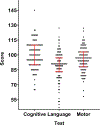Early Predictors of Poor Neurologic Outcomes in a Prospective Cohort of Infants With Antenatal Exposure to Zika Virus
- PMID: 35144270
- PMCID: PMC8901197
- DOI: 10.1097/INF.0000000000003379
Early Predictors of Poor Neurologic Outcomes in a Prospective Cohort of Infants With Antenatal Exposure to Zika Virus
Abstract
Background: Identify early predictors of poor neurodevelopment in infants with antenatal Zika virus (ZIKV) exposure.
Methods: Analysis of a prospective cohort of infants with antenatal ZIKV exposure confirmed by maternal or infant RT-PCR or IgM during the epidemic in Rio de Janeiro, Brazil. Clinical findings before 3 months of age were associated with Bayley-III Scales of Infant and Toddler Development conducted after 6 months of age.
Results: ZIKV exposure was confirmed in 219 cases; 162 infants were normocephalic, 53 were microcephalic, 4 had no head circumference recorded because of perinatal death/LTFU. Seven of the 112 normocephalic infants developed secondary microcephaly between 3 weeks and 8 months of age. Among the normocephalic at birth cohort, the mean HCZ among normal, at risk, and developmentally delayed children was significantly different (ANOVA, P = 0.02). In particular, the mean HCZ of the developmentally delayed group was significantly lower than that of the normal group (Tukey's test, P = 0.014). HCZ was more strongly associated with lower expressive language scores (P = 0.04) than receptive language scores (P = 0.06). The rate of auditory abnormalities differed among the normal, at risk, and developmentally delayed groups (Chi-squared test, P = 0.016), which was driven by the significant difference between the normal and at risk groups (post hoc test, P = 0.011, risk ratio 3.94). Auditory abnormalities were associated with both expressive and receptive language delays (P = 0.02 and P = 0.02, respectively).
Conclusions: Clear predictors of neurodevelopment in normocephalic ZIKV-exposed children have not been previously identified. Our findings demonstrate that smaller HCZ and auditory abnormalities in these infants correlate with poor neurodevelopment as toddlers. Language delay is the most prominent developmental concern among these children, who will require frequent auditory and speech evaluations throughout childhood.
Trial registration: ClinicalTrials.gov NCT03255369.
Copyright © 2021 Wolters Kluwer Health, Inc. All rights reserved.
Conflict of interest statement
The authors have no conflicts of interest to disclose.
Figures




